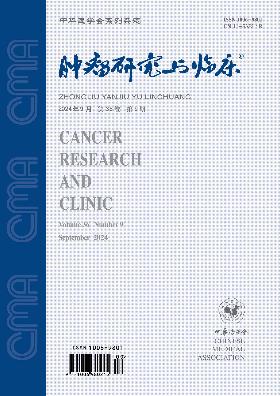中性粒细胞与淋巴细胞比值及血小板与淋巴细胞比值在直肠癌新辅助治疗中的意义
Q4 Medicine
引用次数: 0
摘要
目的探讨中性粒细胞与淋巴细胞比值(NLR)和血小板与淋巴细胞比值(PLR)在直肠癌新辅助治疗中的意义。方法回顾性分析2013年11月至2015年1月在山西省肿瘤医院接受新辅助治疗的86例直肠癌患者资料,分析NLR、PLR变化与患者临床病理特征及治疗效果的相关性。结果治疗后NLR增高43例,PLR增高43例。直肠癌患者新辅助治疗前后NLR、PLR变化与年龄、性别、TNM分期、淋巴结转移、癌结节数、肿瘤直径无关(P < 0.05)。治疗后NLR和PLR的比例随着肿瘤到肛门距离的增加而增加(0.05)。结论直肠癌患者新辅助治疗前后NLR的变化与治疗效果有关。关键词:直肠肿瘤;Neutrophil-to-lymphocyte比率;Platelet-to-lymphocyte比率;新辅助治疗本文章由计算机程序翻译,如有差异,请以英文原文为准。
Significance of changes of neutrophil-to-lymphocyte ratio and platelet-to-lymphocyte ratio in neoadjuvant therapy for rectal cancer
Objective
To investigate the significance of changes of neutrophil-to-lymphocyte ratio (NLR) and platelet-to-lymphocyte ratio (PLR) in neoadjuvant therapy for rectal cancer.
Methods
The data of 86 patients with rectal cancer who received neoadjuvant therapy from November 2013 to January 2015 in Shanxi Provincial Cancer Hospital were retrospectively analyzed, and the correlations of NLR and PLR changes with the patients' clinicopathological characteristics and therapeutic effects were also analyzed.
Results
There were 43 cases of increased NLR and 43 cases of increased PLR after treatment. NLR and PLR changes before and after neoadjuvant therapy in patients with rectal cancer were not associated with age, gender, TNM stage, lymph node metastasis, number of cancer nodules, and tumor diameter (all P > 0.05). The increasing proportion of NLR and PLR after treatment in patients with the distance from the tumor to anus 0.05).
Conclusion
NLR changes are associated with therapeutic efficacy before and after neoadjuvant therapy for patients with rectal cancer.
Key words:
Rectal neoplasms; Neutrophil-to-lymphocyte ratio; Platelet-to-lymphocyte ratio; Neoadjuvant therapy
求助全文
通过发布文献求助,成功后即可免费获取论文全文。
去求助
来源期刊

肿瘤研究与临床
Medicine-Oncology
CiteScore
0.10
自引率
0.00%
发文量
7737
期刊介绍:
"Cancer Research and Clinic" is a series of magazines of the Chinese Medical Association under the supervision of the National Health Commission and sponsored by the Chinese Medical Association.
It mainly reflects scientific research results and academic trends in the field of malignant tumors. The main columns include monographs, guidelines and consensus, standards and norms, treatises, short treatises, survey reports, reviews, clinical pathology (case) discussions, case reports, etc. The readers are middle- and senior-level medical staff engaged in basic research and clinical work on malignant tumors.
 求助内容:
求助内容: 应助结果提醒方式:
应助结果提醒方式:


